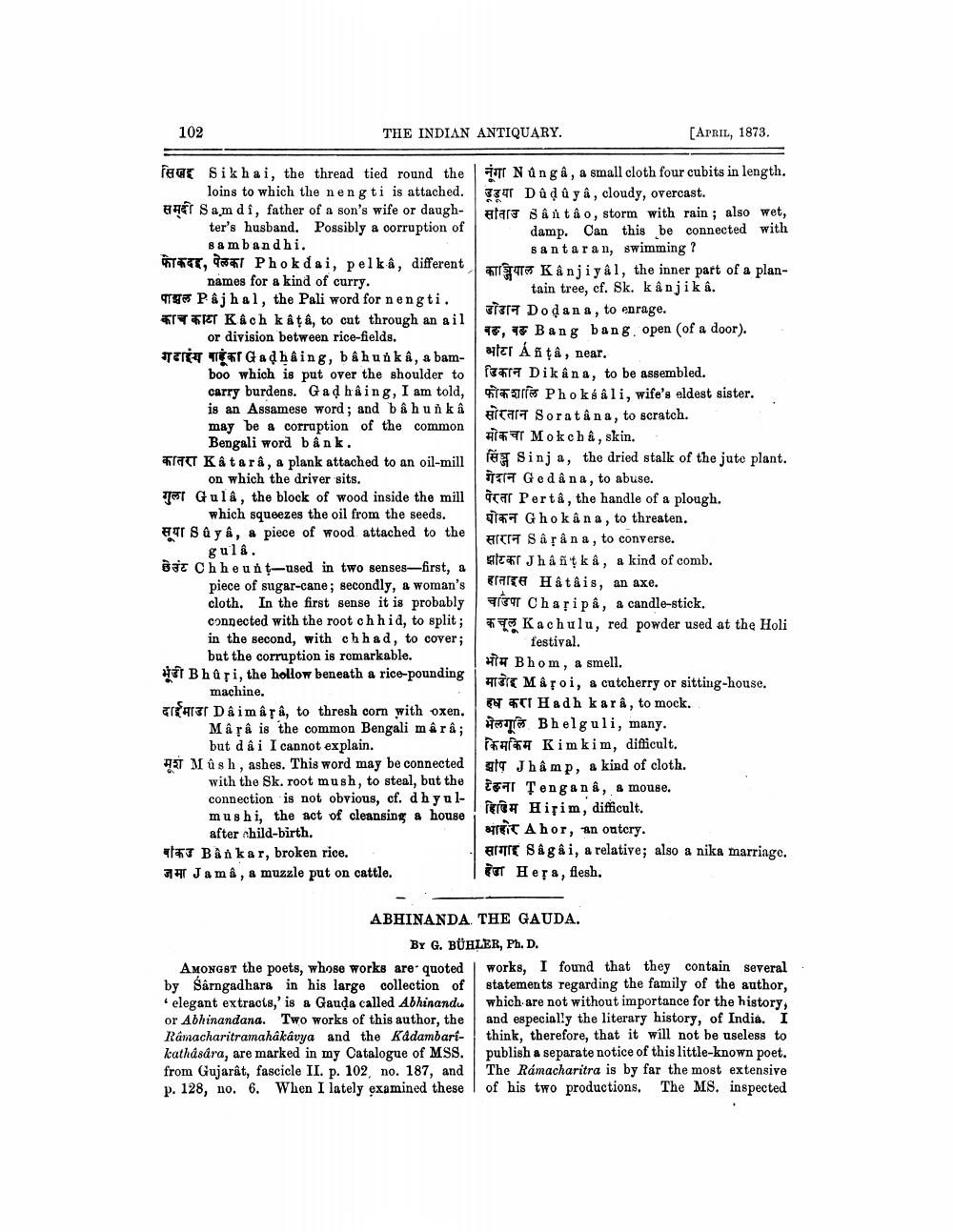________________
102
THE INDIAN ANTIQUARY.
[APRIL, 1873.
faur Sikhai, the thread tied round the IT Nanga, a small cloth four cubits in length.
loins to which the neng ti is attached. 34 Dûd û yâ, cloudy, overcast. 441 Sam da, father of a son's wife or daugh- atara sant å o, storm with rain ; also wet,
ter's husband. Possibly a corruption of damp. Can this be connected with Bambandhi.
santaran, swimming ? TUE, a Phokdai, pelka, different TE Kânjiyal, the inner part of a plannames for a kind of curry.
tain tree, cf. Sk. k anjika. TE Pajhal, the Pali word for nengti.
37317 Dodana, to enrage. & Kach k at a, to cut through an ail or division between rice-fields.
T6, 16 Bang bang. open (of a door). TUIT TE Gadhaing, båhunka, a bam
sfer Anța, near. boo which is put over the shoulder to f319 Dikâna, to be assembled. carry burdens. Gad haing, I am told,
s Phoksali, wife's eldest sister. is an Assamese word; and b â hunk a
#itara Soratâna, to scratch. may be a corruption of the common Bengali word bank.
HET Mokcba, skin. ATT Katara, a plank attached to an oil-mill Sinj a, the dried stalk of the jute plant. on which the driver sits.
I Gedâna, to abuse. Test Guld, the block of wood inside the mill acar Perta, the handle of a plough.
which squeezes the oil from the seeds. * Ghoka na, to threaten. Saya, a piece of wood attached to the
Hit Så så na, to converse. gula. Bat Chheunt-used in two senses—first, a
# Jhâñtka, a kind of comb. piece of sugar-cane; secondly, a woman's
grarka H&tâis, an axe. cloth. In the first sense it is probably TT Chasipa, a candle-stick. connected with the root chhid, to split; Kachulu, red powder used at the Holi in the second, with chhad, to cover;
festival. but the corruption is remarkable.
# Bhom, a smell. HET Bhûsi, the hollow beneath a rice-pounding
ATIK Mâroi, a catcherry or sitting-house. machine.
Hadh karâ, to mock. Karar Daimîrê, to thresh corn with oxen. Marê is the common Bengali mârâ;
To Bhelguli, many. but d â i I cannot explain.
FRA Kimkim, difficult. ET Mûsh, ashes. This word may be connected gly Jhâmp, a kind of cloth. with the Sk. root mush, to steal, but the
26 Tengana, & mouse. connection is not obvious, cf. dh yulmushi, the act of cleansing a house
! REICH Hisim, difficult. after child-birth.
are Ahor, an outcry. Wat Bankar, broken rice.
ATE Sagai, a relative; also a nika marringe. ah Jama, a muzzle put on cattle.
E Hesa, flesh.
ABHINANDA. THE GAUDA.
BY G. BÜHLER, Ph. D. AMONGST the poets, whose works are quoted works, I found that they contain several by Sarngadhara in his large collection of statements regarding the family of the author,
elegant extracts,' is & Gauda called Abhinandu which are not without importance for the history, or Abhinandana. Two works of this author, the and especially the literary history, of India. I Ramacharitramahâkavya and the Kadambari- think, therefore, that it will not be useless to kathására, are marked in my Catalogue of MSS. publish a separate notice of this little-known poet. from Gujarât, fascicle II. p. 102, no. 187, and The Ramacharitra is by far the most extensive p. 128, no. 6. When I lately examined these of his two productions. The MS. inspected




